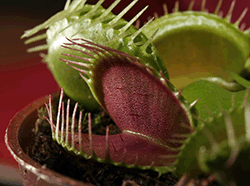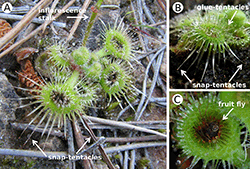
What's in the Story?
Imagine an insect watching a horror movie. Spooky music plays in the background. It senses something bad is about to happen – but what? A fly enters the picture and lands on a plant with some inviting moisture drops. KERPOW! The sudden flick of a green tentacle flings the insect onto the moisture drops, which turn out to be a glue-like substance that holds the prey so it cannot escape. More tentacles surround the insect, drawing it slowly towards its death. The screen goes dark.
The monster in this film? Drosera glanduligera, a carnivorous sundew from southern Australia.
All species of sundew plant are carnivorous, complete with sticky glue drops on their tentacles to attract bugs. The Australian version of the sundew comes with an added feature—a non-sticky, snap-tentacle that moves faster than the blink of an eye to catapult its prey to an untimely demise.

Do you remember Ron Weasley, the sidekick who helped Harry Potter defeat Lord Voldemort? The sundew is like Ron, often ignored because of its more famous relative the Venus flytrap. Now the sundew gets the spotlight in the PLOS One article, “Catapulting Tentacles in a Sticky Carnivorous Plant.”
Revenge of a meat-eating plant
Plants are usually the ones being eaten, but every now and then, a plant gets sweet revenge and bites back. The Australian sundew is one such plant.
Thirsty insects see raindrops on the leaves of these plants, which attracts them. But this “water” is actually a very, very sticky glue-like substance used by the plant to trap the bugs. When the insect happens to land on the leaf, it gets—you guessed it—very, very stuck. Talk about a sticky situation.
Bloodthirsty Plants
They snap, they trap, they stick and they suck. This is the bizarre world of carnivorous plants.
Just because they developed a taste for meat doesn’t make them monsters. Evolution made them desperate. The ability to trap and kill insects is an adaptation to living in places that don’t have many nutrients in the soil. These plants have to get nutrients somehow, so they trap and digest insects. But how do they get these insects into their digestive concavity, or the ‘mouth’, in the first place?
How do carnivorous plants digest insects?
Researchers filmed how long it took the sundew’s tentacles to respond using high-speed video cameras.

After a snap-tentacle senses contact, it takes only 400 milliseconds before it springs into action. What happens is the snap-tentacle bends at a point halfway down and swings the insect into the center of the plant with a speed as fast as 0.17 meters per second. This is 8 times faster than the fruit fly can fly.
The sticky glue on the inner tentacles makes sure the helpless bug doesn’t escape. The plant then releases enzymes that break down the fly into a meal that it can eat. Dinner is served.
It’s a Trap!
In the famous story about a race between the tortoise and the hare, the tortoise won even though it’s naturally a slower animal than the hare. Plants aren’t exactly known for being the fastest organisms in the world since they’re planted in the ground. The secret to success is its lightning-fast tentacles.
The quick bending and fast action of the tentacles is probably because of a hydraulic transport system. This involves water moving quickly between the plant cells. If a cell loses water it contracts, and if it gains water it expands. This could help explain why the tentacle bends when it senses contact. It suddenly releases pent-up hydraulic pressure, catapulting the insect to the sticky tentacles, which then draw the insect towards its digestive concavity.
Sneaky Sundew

Once a tentacle flings an insect, it can’t go back to its original position and fling another unsuspecting insect. Each tentacle is basically a one-trick pony since it can only flip once. But no problem. Since this sundew is a short-lived annual plant, it can grow new leaves every three to four days. Clearly, the ability to catch tasty flies and get nutrients helped the sundew evolve fast-acting tentacles.
So What Does This Mean?
Scientists may have unveiled the mystery of how the tentacles work, but this also brings up new questions. How much mass can these tentacles lift? Can these plants catch insects at the same rate as carnivorous plants that don’t have tentacles? The possibilities are endless.
If you have a bug problem at home, plant a sundew. It would be a great replacement for a flyswatter. But if you don’t feel like watching a horror movie, here’s some comedy: How many tickles does it take to grab an insect? Ten-tickles!
Additional iimages from Wikimedia Commons
Read more about: Jaws of Death: When Plants Bite Back
Bibliographic details:
- Article: Jaws of Death: When Plants Bite Back
- Author(s): Veerta Singh
- Publisher: Arizona State University School of Life Sciences Ask A Biologist
- Site name: ASU - Ask A Biologist
- Date published:
- Date accessed:
- Link: https://askabiologist.asu.edu/plosable/carnivorous-sundew
APA Style
Veerta Singh. (). Jaws of Death: When Plants Bite Back. ASU - Ask A Biologist. Retrieved from https://askabiologist.asu.edu/plosable/carnivorous-sundew
Chicago Manual of Style
Veerta Singh. "Jaws of Death: When Plants Bite Back". ASU - Ask A Biologist. . https://askabiologist.asu.edu/plosable/carnivorous-sundew
Veerta Singh. "Jaws of Death: When Plants Bite Back". ASU - Ask A Biologist. . ASU - Ask A Biologist, Web. https://askabiologist.asu.edu/plosable/carnivorous-sundew
MLA 2017 Style

The rare carnivorous Australian Sundew plant captures its prey by using tentacles and a glue-like substance.
Be Part of
Ask A Biologist
By volunteering, or simply sending us feedback on the site. Scientists, teachers, writers, illustrators, and translators are all important to the program. If you are interested in helping with the website we have a Volunteers page to get the process started.
